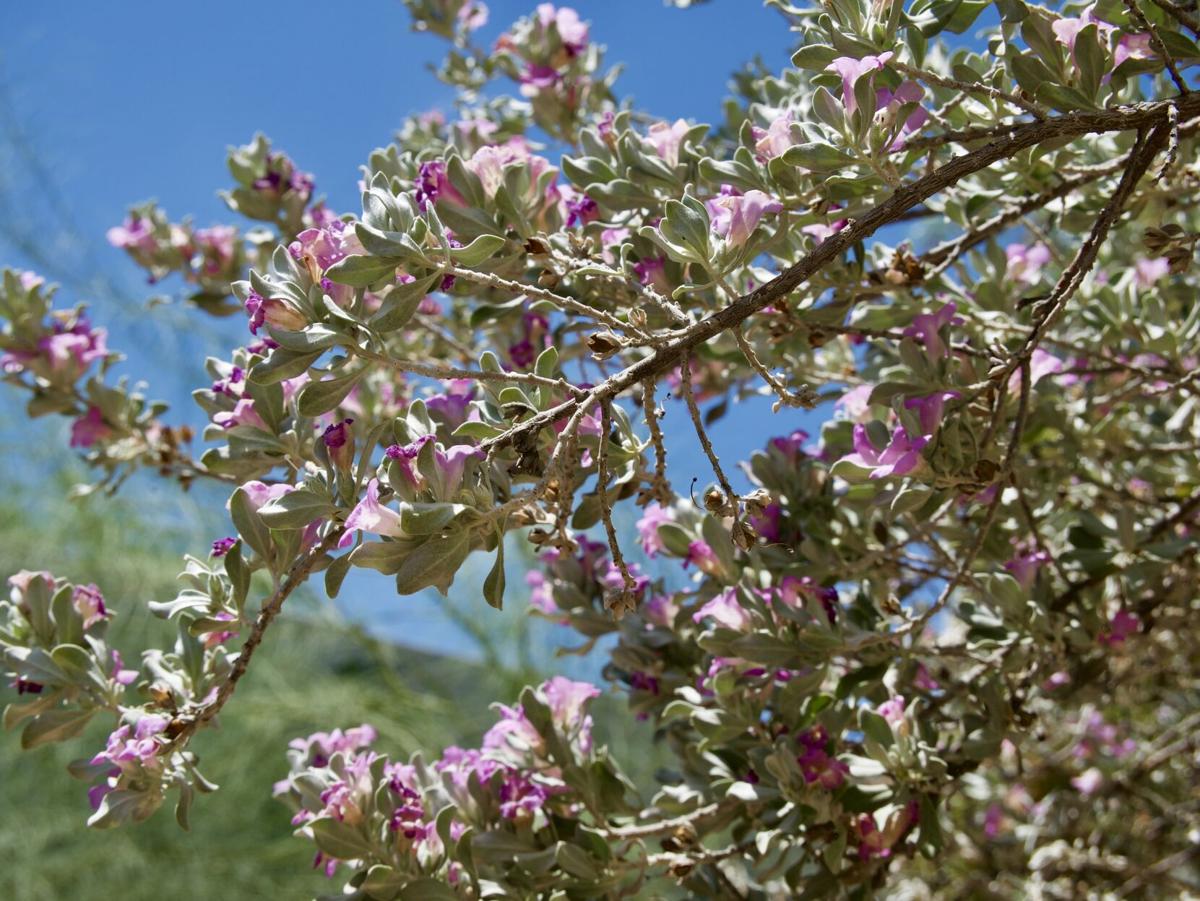Texas sage shrubs, also called Texas rangers (Leucophyllum frutescens), are a familiar sight in Tucson. Older houses in particular may have large specimens of this plant. The Texas sage is native to the Chihuahuan Desert, which is right next door to our own Sonoran Desert. It can grow at a moderate to fast rate up to six feet wide and tall and has beautiful purple flowers when watered or after rain.
Texas sage is a popular plant in Arizona — it can handle full and reflected sun, survives long periods of drought once established, and is hardy to temperatures down to 10 degrees Fahrenheit. It’s fast-growing and makes a great hedge. Birds love it. My large bushes are always hosting large groups of various birds. For all intents and purposes, it’s a native plant, coming from only a few hundred miles away. It is sometimes referred to as the “barometer bush” because it flowers in periods of high humidity and rain — signaling the monsoon season. It also doesn't require pruning.
It does tend to spread a lot, which is a potential problem. It’s probably not a good idea to plant it somewhere where it might crowd out native plants. In my relatively small yard, this has been an issue since I now have several volunteer Texas sages in various areas. Some of these I will keep — I have one in front of my bedroom window on a west-facing wall and I plan to prune it into a tree shape to shade the window from the afternoon sun. In some cases, however, I have waited too long to remove volunteers, and it will be a project to get them out of my yard!
This plant seems to have fallen out of favor with landscape designers. Most of the specimens in town are on older properties, such as my own. Why is this the case? I think there are two main reasons that it’s less popular now. One, landscape design, like other design professions, tends to go through phases where certain plants go out of style. The Texas sage seems to be one of those plants. Another reason, however, is that it’s most attractive when left in its natural shape but most landscapers insist on trimming these plants into a “meatball” shape like a formal hedge. This tends to give yards a very dated look and does not go well with most Southwest style houses. Over time, the harsh pruning makes the plant very woody with thick trunks and less foliage and flowers; meatball pruning also stresses the plant and reduces its lifespan.
My own Texas sage bushes were trimmed that way until I learned more about pruning. But if you have a landscaper coming each month or two, chances are he or she will trim your Texas sage like a formal hedge. Eventually your plant will be a thick-stemmed unattractive bush and have fewer leaves and flowers. Once it’s at this stage, it’s difficult to bring it back to its natural shape. You can try to cut it back severely (to the ground) and hope it comes back; it may end up sprouting sucker-like branches, however, rather than growing into its natural shape. You may need to dig out the old one and start afresh.
With my own bushes, I have been gently pruning back the larger branches to see if they will sprout back with leafy growth. I have also spent quite a bit of time pruning out interior branches, which have no leafy growth whatsoever. This is difficult and time-consuming, but my bushes are otherwise large and look healthy, so I hate to dig them out. They haven’t been trimmed like a hedge in several years, and they are looking considerably better. It’s a work in progress, but I like this plant enough that I am willing to put the work in—and put up with the scratches I get as a result.
There are helpful guides available from the University of Arizona Cooperative Extension on how to prune Texas sage shrubs and pruning other shrubs in the Arizona desert.
Related species of Leucophyllum are available as well, with some varieties being smaller or producing more flowers. It's worth checking them out to see which ones meet your needs. They can be found at Spadefoot Nursery, Desert Survivors, Civano Nursery, and Harlow Gardens.
Pros and cons of Texas sage; Leucophyllum frutescens
Pros:
• Hardy to 10 degrees Farenheit
• Can handle even reflected Tucson sunlight
• Native to Chihuahuan desert and supports native wildlife
• Bees and birds love it
• Pretty purple flowers after rain or deep watering
• Can survive with very little watering once established
• Good option for shading or informal privacy hedge
Cons:
• Spreads easily in yards and can be difficult to remove
• Pruning requires awareness and knowledge
• If pruned incorrectly can turn woody and unattractive





